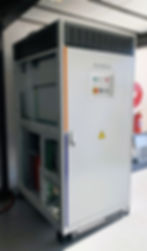Nominal DC Operational Voltages: Why is it so important?
- tiaan.botha
- Jun 26, 2023
- 3 min read

When designing a Renewable Energy Storage system there a various aspects to consider towards compatibility of an efficient, reliable ESS. DC nominal operational voltages are one of the very important aspects and play a crucial role in the compatibility and efficiency of LiFePO4 (Lithium Iron Phosphate) Energy Storage Systems (ESS) and Power Conversion Systems (PCS). Here's why they are important:
Voltage Matching: The DC nominal operational voltage refers to the standard voltage at which the system is designed to operate. Both the ESS and PCS are designed to work optimally within a specific voltage range. Matching the nominal voltages ensures compatibility between the two systems. If the ESS and PCS have significantly different nominal voltages, it can lead to compatibility issues and inefficient power conversion.
Efficiency: Power conversion systems, such as inverters or converters, are responsible for converting the DC voltage from the ESS to the required AC voltage for various applications. Efficient power conversion requires a close match between the input and output voltage levels. When the nominal voltages are well-matched, the power conversion process can be optimized, resulting in higher efficiency and reduced energy losses.
Safety: Operating electrical systems at their intended nominal voltages is important for safety reasons. Electrical components, such as cables, connectors, and circuit breakers, are rated to handle specific voltage levels. Deviating significantly from the nominal voltage can exceed the capacity of these components, leading to increased risk of electrical failures, overheating, or even electrical hazards like short circuits or fires. Therefore, adhering to the nominal voltage ratings ensures the safe and reliable operation of the systems.
Standardization: Nominal voltage values are often standardized within the industry to promote interoperability and compatibility. By adhering to standard nominal voltages, manufacturers can ensure that their products can be easily integrated into existing systems or used interchangeably with other compatible components. Standardization simplifies system design, installation, and maintenance processes, providing convenience and flexibility for end-users.
In the context of LiFePO4 ESS and PCS, maintaining compatibility and efficiency through proper voltage matching is crucial to achieve reliable and optimal performance. Adhering to the specified DC nominal operational voltages ensures smooth integration, improved efficiency, and enhanced safety of the overall system.
This is a list of Compatible PCS for the Solar MD High Voltage Energy Storage range:
Sungrow
SC630 (580-850Vdc) - Solar MD SS7019 - SS7021 HV ESS
SC1200/SC1375UD (700/800-1500Vdc) - Solar MD SS7021 - SS7024 HV ESS
*The Sungrow SC1200/SC1375 UD PCS series is an outdoor rated PCS and does not need to be installed into the container. If installed in a container, a 40ft high cube needs to be used based on the height of the PCS. Isolation transformer required.


Kehua Tech
BCS-A PCS (500-900Vdc) - Solar MD SS7016 - SS7023 HV ESS
*This PCS already has it's isolation transformer built-in and can be installed up 6x in parallel.

ATESS
HPS (352-600Vdc) - Solar MD SS7011 - SS7016 HV ESS
PCS250 (500-820Vdc) - Solar MD SS7016 - SS7020 HV ESS
PCS500/PCS630 (600-900Vdc) - Solar MD SS7019 - SS7023 HV ESS
AEG
Convert SC Flex (330-1000Vdc) - Solar MD SS7011 - SS7024 HV ESS
*Max Charge voltage - 970Vdc. Min Discharge voltage - 330Vdc. 1MW PCs generally used for Commercial projects

Sinexcel
PWG2-100K-EX (250V-520Vdc) - Solar MD SS7011 - SS7014 HV ESS

Deye/Sunsynk 50kW HV Hybrid Inverters (450-850Vdc) - Solar MD SS7014 - SS7021 HV ESS


*Start up voltage 180Vdc. Max power on inverter when battery voltage exceeds 500V. Inverter can be installed in parallel but not batteries.
This is a link to a Low Voltage inverters compatible with Solar MD Energy Storage systems and their respective compatibility guides: https://www.solarmd.com/inverter-compatibility-solar-md